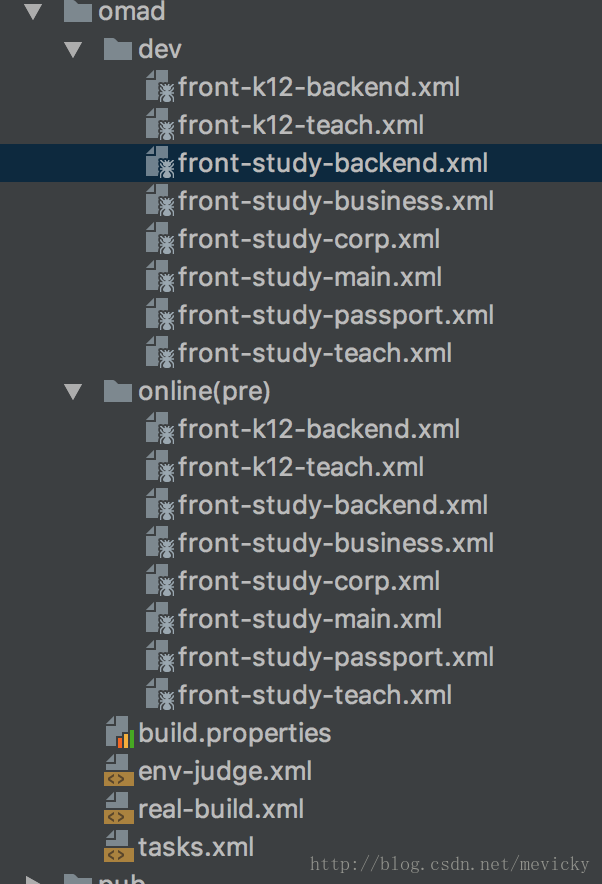原文:https://blog.csdn.net/mevicky/article/details/72828554
前言
国内关于build.xml的配置资料太零散了,实在是受不了,故而将自己的笔记整理成博文,方便大家查阅和理解。
build.xml配置参数
构建文件默认叫build.xml,其有很多配置参数。
project
每个构建文件都有一个project标签,有以下属性:
- default:表示默认的运行目标,这个属性是必须的。
- basedir:表示项目的基准目录。
- name:表示项目名。
- description:表示项目的描述。
如下:

每个项目对应一个构建文件,但是如果项目比较复杂,业务线比较多,则有可能对应很多个构建文件,比如:

这时我们需要注意,每个构建文件都需要以project标签包含起来。
property
类似于常量,可以供给build.xml中的其他标签使用。有两个特点:
- 大小写敏感
- 不可改变,谁先设定,之后的都不能改变。
该标签可以与多个属性配合使用。
- name和value:
<property name="module_name" value="admin"/>
后面直接使用即可:
<echo message="begin nej-build ${module_name}..."/>
- name和refid:
<property name="srcpath" refid="dao.compile.classpath"/>
其中的dao.compile.classpath在别的地方进行了定义。当然,也可以通过直接引用的方式:
<property name="baseline.dir" value="${ob_baseline.dir}"/>
- name和location:
<property name="srcdir" location="src"/>
将srcdir的值设置为当前文件路径/src。
- file:
<property file="./omad/build.properties"/>
导入相对文件中的所有变量,这里的build.properties专门用来存放各种变量,示例如下:

url:
<property url="http://www.mysite.com/bla/props/foo.properties"/>
导入对应文件的属性
environment:
<property environment="env"/>
设置系统的环境变量前缀为env。比如
<property name="tomcat.home" value="${env.CATALINA_HOME}"/>
将系统的tomcat安装目录设置到tomcat.home属性中。
import
引入别的xml文件,提高复用性:
<import file="./env-judge.xml"/> <import file="./tasks.xml"/>
甚至可以批量匹配:
<copy todir="${basedir}/src/html/${html.dir}" overwrite="true" includeEmptyDirs="true"> <fileset dir="${basedir}/lib"> <include name="module-*/**" /> </fileset> </copy>
target
任务,一个project标签下有一个或多个target标签,代表任务,任务间可以存在依赖关系。有如下属性:
- name:用于标识,这个是必须的
- depends:用来指定所依赖的任务。
<!-- 初始化任务 --> <target name="init"> <echo message=" init ${init} ..."/> </target> <!-- 编译 --> <target name="compile" depends="init"> <delete dir="${classes.dir}" /> <mkdir dir="${classes.dir}" /> <javac srcdir="${src.dir}" destdir="${classes.dir}"> <classpath refid="master-classpath" /> </javac> </target> 1 if:当属性设置时才执行该任务。 <target name="sync_module_k12_teach" if="${is_k12_teach}"> <antcall target="sync_module_item"> <param name="html.dir" value="org"/> </antcall> </target> <target name="sync_module_backend" if="${is_backend}"> <antcall target="sync_module_item"> <param name="html.dir" value="admin"/> </antcall> </target> <target name="sync_module_k12_backend" if="${is_k12_backend}"> <antcall target="sync_module_item"> <param name="html.dir" value="admin"/> </antcall> </target>
通过判断变量是否存在,执行不同的任务。
- unless:当属性未设置时才执行。
- description:任务描述。
echo
控制台显示
<echo message="begin clean res/module-xx、component-xx、res-base..."/>
delete
删除文件或文件目录,有如下属性
- file:删除文件
- dir:删除目录
- includeEmptyDirs:值得是否删除空目录,默认是true
- failonerror:报错是否停止,默认是true
- verbose:是否列出删除的文件,默认是false
示例如下:
<!--clean other dir--> <target name="clean_other_dir"> <echo message="begin clean_other_dir..."/> <delete dir="${basedir}/${compress.dir}"/> <delete dir="${basedir}/pub"/> <echo message="begin clean html module-xx..."/> <delete includeemptydirs="true"> <fileset dir="${basedir}/src/html" > <include name="**/module-*/**"/> </fileset> </delete> <echo message="begin clean res/module-xx、component-xx、res-base..."/> <delete includeemptydirs="true"> <fileset dir="${basedir}/res" > <include name="module-*/**"/> <include name="component-*/**"/> <include name="res-base/**"/> </fileset> </delete> </target>
mkdir
创建一个目录
<mkdir dir=”${class.root}”/>
copy
拷贝文件或文件目录,属性如下:
- file:表示源文件。
- tofile:表示目标文件。
- todir:表示目标目录。
- overwrite:是否覆盖目标文件,默认为false。
- includeEmptyDirs:是否拷贝空目录,默认为true。
- failonerror:如目标没有发现是否自动停止,默认值true。
- verbose:是否显示详细信息,默认值false。
示例:
<target name="cp"> <copy todir="${compress.dir}" overwrite="true"> <fileset dir="${ob_baseline.dir}"> <include name="pub/" /> <include name="res/" /> <include name="mail_template/" /> </fileset> </copy> </target>
fileset
文件集标签,通常与任务结合来使用,例如上面的copy的demo中,通过将fileset定义的文件路径下的文件,拷贝到todir指定的路径中。
也可以用于批量删除:
<delete includeemptydirs="true"> <fileset dir="${basedir}/src/html" > <include name="**/module-*/**"/> </fileset> </delete> <echo message="begin clean res/module-xx、component-xx、res-base..."/> <delete includeemptydirs="true"> <fileset dir="${basedir}/res" > <include name="module-*/**"/> <include name="component-*/**"/> <include name="res-base/**"/> </fileset> </delete>
也就是说,但凡遇到文件集操作,都需要用到fileset标签。
exec
用来执行系统命令,或者指定环境的命令。
比如:
<target name="test"> <exec executable="cmd.exe"> <arg line="/c dir"/> </exec> </target>
打开命名行,并转到c盘执行dir命令。
能够执行系统命令,就相当于可以执行各种环境比如node、gulp、bower等等:
<!--build style--> <target name="build_style"> <echo message="begin build_style..."/> <exec dir="." executable="gulp" failonerror="true"> <arg line="scss"/> </exec> </target> <!--bower cache clean if必须是${]才是判断true,false, 否则只要有设定值即可执行--> <target name="bower_cache_clean" if="${is_bower_cache_clean}"> <echo message="begin bower_cache_clean ..."/> <exec dir="." executable="bower" failonerror="true"> <arg line="cache clean" /> </exec> </target>
antcall
执行某个定义的任务。
<target name="sync_module_teach" if="${is_teach}"> <antcall target="sync_module_item"> <param name="html.dir" value="org"/> </antcall> </target>
执行sync_module_item任务,并设置参数html.dir的值为org。
该任务定义如下:
<target name="sync_module_item"> <echo message="begin sync_module ${html.dir}..."/> <copy todir="${basedir}/src/html/${html.dir}" overwrite="true" includeEmptyDirs="true"> <fileset dir="${basedir}/lib"> <include name="module-*/**" /> </fileset> </copy> </target>
或者更为简单的表达:
<target name="deploy"> <echo message="begin auto deploy......"/> <antcall target="clean"/> <antcall target="bower_install"/> <antcall target="cnpm_install"/> <antcall target="sync_module"/> <antcall target="build_style"/> <antcall target="nej_build" /> <antcall target="cp"/> </target>
parallel
并行执行多个子任务。
<parallel failonany="true"> <antcall target="sync_module_corp"/> <antcall target="sync_module_main"/> <antcall target="sync_module_teach"/> <antcall target="sync_module_backend"/> <antcall target="sync_module_passport"/> <antcall target="sync_module_business"/> <antcall target="sync_module_k12_teach"/> <antcall target="sync_module_k12_backend"/> <antcall target="build_style"/> </parallel>
通过failonany控制如果一个失败,则不执行。通过并行执行,来提升性能,降低构建花费的时间。
regexp
用于正则的定义的使用,可以与matches结合使用。
比如,定义正则:
<regexp id="regexp_env_test" pattern="^${root_dir}/(${test_dir}|${test_k12_dir})/.+"/> <regexp id="regexp_env_pre" pattern="^${root_dir}/(${pre_dir}|${pre_k12_dir})/.+"/>
通过pattern指定正则内容,通过id标识。
在需要匹配的时候,使用之:
<condition property="is_test"> <matches string="${basedir}"> <regexp refid="regexp_env_test"/> </matches> </condition>
condition
用来判断,如果包含的内容符合条件,则将property指定的属性设置为true,否则为false。
比如上面的例子中,就是将basedir变量的值和regexp_env_test对应的正则匹配,如果正确,就将is_test设置为true,然后后面的流程再去判断。
与之配合的标签有很多,下面一一介绍:
- istrue,isfalse:断言
<condition property="is_test_backend"> <and> <istrue value="${is_test}"/> <istrue value="${is_backend}"/> </and> </condition>
只有is_test和is_backend变量的值均为true,is_test_backend的值才为true。
- and:逻辑与,需要都满足条件才行,如上例所述。
- not:逻辑非,反过来的结果。
- or,xor:逻辑或和逻辑异或。
- isset:指定属性是否存在:
<condition property="scondition"> <!--如果属性name不存在则返回false--> <isset property="name"/> </condition>
equils:指定属性是否相等:
<condition property="scondition"> <!--如果arg1的值与arg2的值相等返回true,否则为false--> <equals arg1="${name}" arg2="this is name"/> </condition>
filesmatch:指定文件是否相等:
<condition property="scondition"> <!--如果file1所代表的文件与file2所代表的文件相等返回true,否则为false--> <filesmatch file1="testfile1.txt" file2="testfile2.txt"/> </condition>